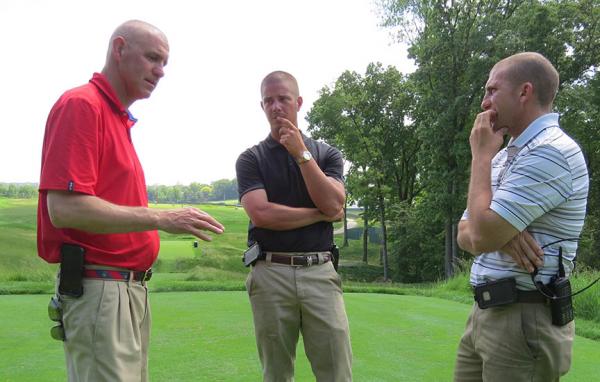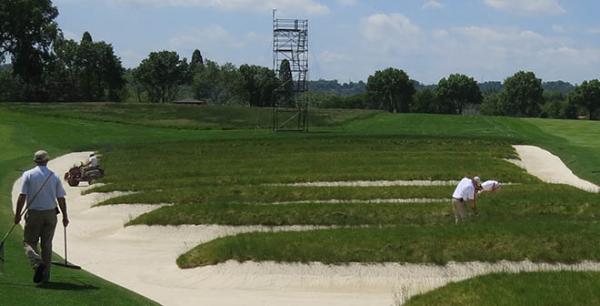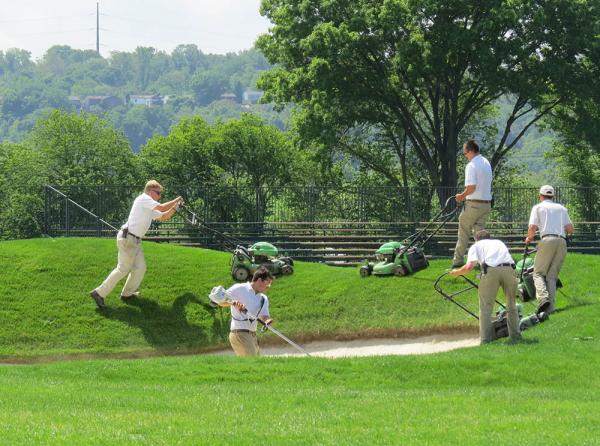 For someone who designed only one golf course, Henry Clay Fownes definitely got things right in his only trip to the drawing board.
For someone who designed only one golf course, Henry Clay Fownes definitely got things right in his only trip to the drawing board.
A 19th century industrialist and steel magnate from Pittsburgh, Fownes built his lone work, Oakmont Country Club, in 1903 on rolling farmland northeast of the city with the sole purpose of creating the most challenging golf course in the world. More than 100 years later, Oakmont has stood the test of time with the reputation of being perhaps the world's most difficult layout. Just this week, Phil Mickelson, in preparation for this year's U.S. Open, called Oakmont the hardest course he has ever played.
"H.C. Fownes was light years ahead of his time in regard to golf course architecture, and without any experience," said U.S. Open Championship Manager Charlie Howe of the USGA.
"From Day 1, the idea was that this course was going to be more difficult and more challenging to the everyday golfer than any other golf course."
Mission accomplished as Fownes' design incorporated concepts and techniques not often seen before World War I. Called "a brute" by one member, Oakmont has confounded everyday golfers and the pros ever since.
On the brink of a record ninth U.S. Open set for June 16-19, Oakmont today looks a lot like it did when Fownes put it in the ground thanks to an aggressive tree-management plan that claimed about 7,000 trees prior to the 2007 U.S. Open, and a total of about 15,000 in the past two decades. All or parts of 17 holes are visible from the clubhouse porch, as was the case in the club's early days.
Oakmont also has managed to keep up with the times thanks in part to foresight by Fownes, a membership determined to preserve his intentions and the work of superintendent John Zimmers and his crew. The club and the USGA both have made sizeable investments in infrastructure that ensure Oakmont's place in U.S. Open history for years to come.
To understand Oakmont and its relationship with the USGA, it is important to understand Fownes and the members dedicated to carrying on his legacy.
From Day 1, the idea was that this course was going to be more difficult and more challenging to the everyday golfer than any other golf course."
Fownes carved the course to a length of 6,400 yards, considered long for that time, to accommodate the longer, harder Haskell golf ball that was replacing the gutta percha ball, according to the USGA. His son, W.C. Fownes, also tweaked the course through the early days. According to historical records, the course had stretched out to 6,700 yards and was at least 500 yards longer than other courses of the era, according to the USGA.
He also was one of the first architects to give serious consideration to water movement. Pitched greens and ditches not only moved golf balls off the playing surface, they moved water off as well. The club was among the first to use sand topdressing and to roll greens - when machinery was powered by steam, not gasoline or diesel fuel - as Oakmont staked an early claim to the fasted putting surfaces in golf.
"The members here have really embraced his philosophy and his architecture," Zimmers said. "It's more than that. It's the ditches and bunkering. I think they've done everything they can to protect that."
In those early days, Fownes was said to have watched closely as golfers played his course, making notes where adjustments were needed so he could make the layout even more of a challenge.
"It all goes back to the guy who built the golf course. The stories of Mr. Fownes are legendary," said Bob Wagner, U.S. Open co-chairman and a former Oakmont president. "If landing the ball in a certain area meant players gained an advantage, the next day there was a bunker there."
 HC Fownes' thoughts on golf course design are summed up in a quote attributed to him decades ago: "A shot poorly played should be a shot irrevocably lost." It is a philosophy that Oakmont's members have embraced ever since, to the extent that it is stitched into throw pillows for sale in the golf shop.
HC Fownes' thoughts on golf course design are summed up in a quote attributed to him decades ago: "A shot poorly played should be a shot irrevocably lost." It is a philosophy that Oakmont's members have embraced ever since, to the extent that it is stitched into throw pillows for sale in the golf shop."We are just stewards of Oakmont," Wagner said of the club's members. "We keep the place the way Mr. Fownes would want it kept."
Even for those who play the course often, familiarity does not always translate to success.
"When you play it every day, it is still a tough course to play," Wagner said. "It never plays the same way twice, because you can get some crazy lies out there. It's tough, but it's fair. It's not tricked up, it's just a brute."
Because of those tough conditions that have stood up over time, no course is as synonymous with the U.S. Open and USGA championships than Oakmont, which has been on the National Register of Historic Places since 1984. This year's Open will be the 16th USGA championship contested on Fownes' masterpiece that also has seen five U.S. Amateurs and two U.S. Women's Opens. Three PGA Championships also have been played there.
Many of the game's more memorable moments have occurred at Oakmont, solidifying its place in USGA lore.
Bobby Jones won his second U.S. Amateur there in 1925, and two years later, Tommy Armour shot a 76 in a playoff to win the first U.S. Open played at Oakmont. In 1953, Ben Hogan won the second of his three straight majors. Jack Nicklaus beat western Pennsylvania native Arnold Palmer in a playoff for his first professional victory in 1962, and Johnny Miller accomplished the unthinkable in 1973 when he fired a final-round 63 to defeat John Schlee by a stroke.
Miller's final-round, hole-by-hole score (there wasn't a single 5 on his card) still is prominently displayed in the Oakmont clubhouse.
The Stimpmeter was born out of the '35 Open, when former Harvard golfer Edwin Stimpson, who was attending the tournament, watched a putt by Gene Sarazan roll off the green and into a bunker. Stimpson set out to create a device to measure ball roll speed to prove his point. Rather than take Stimpson's concerns to heart, Oakmont's greens only have gotten faster.
To illustrate the speed of Oakmont's greens, Sam Snead once quipped that he tried to mark his ball, but his coin slid off the green.

"The history of the USGA and our championships and Oakmont are intertwined," Howe said. "It is the first golf course to be designated a national historic landmark. It's a special place.
"In that time period, you had names like Bobby Jones and Tommy Armour who won here, and you see the scores then are very similar to the scores now. It is eerily similar to the same golf course over a 100-year period."
Maintaining a link to Fownes' legacy has meant staying current to keep the layout relevant.
Oakmont's greens have evolved over time due to the cultural and agronomic practices to which it is exposed. The result is a unique mix of mostly perennial Poa along with some annual Poa that has been selected over time after decades of double- and triple-mowing at extremely low heights, tons of sand topdressing and a lot of rolling, as well as stress from drought, driving rain, late winters and early summers.
"It has adapted over time," Zimmers said. "I think the good stuff has gotten tougher and better, and some of the weaker stuff has diminished."
The infamous Oakmont Poa never that produces those lightning fast putting conditions never has been replicated in a university setting. A local western Pennsylvania sod grower maintains a nursery - that has been grown from Oakmont plugs. And when he needs some for use on the course, Zimmers sends his own guys to select it, cut it and bring it back.
"These greens are drier and rolled more than any other Poa in the U.S. They have been selected over the past 113 years to take the mechanical stress and maintenance we give it," said David Delsandro, Oakmont's director of U.S. Open Operations and Projects. "We produce these green speeds and firmness, but it's not like we know some secret magic trick that nobody else does. A lot of it is because the grass allows it It's not easy by any means. We are walking a fine line. One rainstorm or one decision either way could tip the scales very, very quickly."
This is golf to our members, but it's also business, and it's high octane when you host the U.S. Open. We have to make decisions to help capture future tournaments."
Delsandro, who spend time as superintendent at Nassau Country Club on Long Island, was the assistant at Oakmont for the 2007 U.S. Open. He says as the turf continues to evolve, so do the maintenance practices as well as the standards.
"In (20)06-08, we were hitting 13 to 13.5 (on the Stimpmeter). We checked it every day, and if we weren't there, we'd bring the roller back out here," Delsandro said. "I didn't think we could do any better, but this year we're at 14. Now, if it's at 13.5, we bring the roller back.
"As the grass evolves, expectations evolve, too."
And that is not about to change any time soon.
"This course is tournament tough all the time," Wagner said. "That culture here has carried over. We keep it tournament tough all day every day. That's the way the membership wants it. That is the way it is maintained."
A member recently questioned whether Oakmont's greens might have reached their breaking point.
"Someone asked if we were expecting too much from these greens," Zimmers said. "Another member answered: 'Yes we are. These greens are pushed to the brink every day.'
"You can't put 14-14.5 speeds every day on a 100-year-old golf course without great infrastructure, fundamental plant health and agronomics.
"I don't mind telling you, I'm pretty proud of what we're doing here."
The course is pretty much the same layout as in 2007 . Among the changes are a graduated rough cut that goes through and not around the bunker complexes, and the fronts of some bunkers have been shaved down to bring them more into play.
That Oakmont is Open-ready at a moment's notice has not gone unnoticed by the USGA.
"They love championships and having them here," said the USGA's Howe. "It's part of their culture.
"It's ready all the time. If you want to come in October, you want to come in August, it is ready."
It is ready from an infrastructure perspective as well.
 A massive $3 million project on the adjacent East Course included moving 700,000 cubic yards of earth to transform 60 acres into usable space for hospitality tents, parking, merchandise sales and a helicopter landing area, making Oakmont one of the largest properties on the U.S. Open circuit, Howe said. Likewise, the USGA invested in permanent roads, electricity and potable water for future championships.
A massive $3 million project on the adjacent East Course included moving 700,000 cubic yards of earth to transform 60 acres into usable space for hospitality tents, parking, merchandise sales and a helicopter landing area, making Oakmont one of the largest properties on the U.S. Open circuit, Howe said. Likewise, the USGA invested in permanent roads, electricity and potable water for future championships.The extra space helps the USGA sell about 300 hospitality tents and suites over 500,000 square feet of temporary flooring. And with the trees out of the way, each hospitality venue will have a view of play during the tournament.
"About four years ago, I had read an article in Golfweek in which someone from the USGA was quoted saying Oakmont was a small site for the U.S. Open," said Wagner, who along with Open co-chairman Rob Hoffman hatched the plan to develop the East Course
"I believe it will help us secure future Opens. The USGA put some money into it. It's not turnkey for them, but it's closer to turnkey than it used to be. They would build temporary roads, and temporary electrical cables. There were a lot of things they had to bring in, and a lot of things they had to bring back out. This way, it's not as much money going in next time.
"This is golf to our members, but it's also business, and it's high octane when you host the U.S. Open. We have to make decisions to help capture future tournaments."
And it is all because one man had a singular vision more than a century ago; a vision that those who came after him have vowed to maintain.

